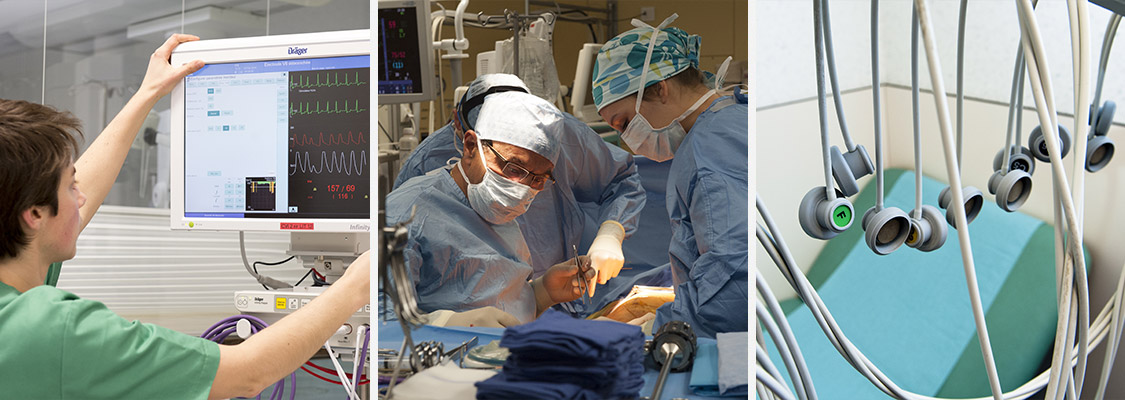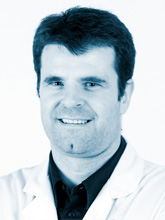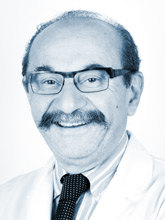Cardiac diseases

The Cardiovascular Department at the Cliniques universitaires Saint-Luc offers a full range of surgical and non-surgical treatments for all kinds of heart disease.
The philosophy of the Cliniques universitaires Saint-Luc is to offer the least invasive, long-lasting treatment possible that will provide the best quality of life for the patient. To ensure that we offer the best treatment, each case is discussed at multidisciplinary meetings between cardiologists, cardiac surgeons, cardiac anaesthetists and other medical and paramedical specialists who may be involved in the patient’s care.
Surgical treatments for valvular diseases
The Cardiac Surgery Division at the Cliniques universitaires Saint-Luc is a pioneer in the treatment of cardiac valve diseases. A number of advanced techniques have been developed here, making our institution an internationally recognized centre of expertise to which surgeons from all over the world come for training.
We have particular expertise in the following 3 surgical techniques:
- Aortic valve repair: over the course of twenty years, the team led by Professor Gébrine El Khoury has operated over a thousand patients suffering from conditions such as Marfan syndrome and bicuspid aortic valve (2 aortic valvular leaflets instead of 3).
- Aortic valve replacement by mechanical valve, biological valve or autograft. The latter procedure, known as the Ross procedure, involves replacing the faulty aortic valve with the patient’s pulmonary valve and in turn replacing this with a donor valve. Over 25 years, nearly 400 of these procedures have been carried out at the Cliniques universitaires Saint-Luc.
- Mitral valve repair: The Cardiac Surgery Division at the Cliniques universitaires Saint-Luc also has 25 years of expertise in the repair of mitral valves. The success rate of such procedures is close to 100%. Today, they are most often carried out with the aid of the Da Vinci robot.
Coronary (artery) bypass
Coronary artery bypass surgery has been carried out at the Cliniques universitaires Saint-Luc since 1985. Thanks to improved prevention and the development of non-surgical techniques, the number of coronary bypass operations has progressively decreased from 500 to 300 per year. “We specialize in using mammary arteries to replace faulty coronary arteries (instead of ankle veins)”, explains Professor El Khoury, head of the Cardiac Surgery Division. “Recently, we have been carrying out these procedures using the Da Vinci robot, which enables us to operate via small incisions”.
Artificial heart
While awaiting a heart transplant, some patients with heart failure may have a ventricular pump implanted in their thorax. This pump then takes over from the left ventricle. Around 30 patients have benefited from this technique since 2007.
Aneurysm treatments
A thoracic and/or abdominal aneurysm is an enlargement of the aorta (the artery that leads from our heart, passing right through our body down to our legs) occurring in the abdomen or thorax. Such aneurysms are treated by replacing the diseased part of the aorta with a prosthetic material using “traditional” surgical techniques. However, at the Cliniques universitaires Saint-Luc, our doctors prefer to carry out this procedure via a catheter inserted in the groin. Each year, around fifty thoracic and abdominal aneurysms are treated by catheter surgery at the Cliniques universitaires Saint-Luc.
Interventional catheterization
Wherever possible, our specialists prefer to use non-surgical treatments. “Structural interventional catheterization is particularly useful as it makes it possible to operate on the structures of the heart (valves, arteries, ventricles, etc) without “opening up” the patient”, explains Professor Christophe Beauloye, head of the Cardiology Division. In this type of treatment, a tiny catheter is introduced via an incision made in the groin and guided up to the heart by following the natural pathway of the blood vessels. Examples of procedures using interventional catheterization include:
- TAVI (Transcatheter aortic valve implantation), ie replacement of the aortic valve by catheterization. This minimally invasive technique is the preferred alternative for high-surgical-risk patients. In Belgium, the Cliniques universitaires Saint-Luc have the largest experience in this field.
- Percutaneous mitral repair or Mitraclip involves clipping together the mitral valve leaflets to make them leak-proof again.
- Paravalvular leak repair (when sutures in a valve become loose or holes form between suture points).
- Closure of abnormal communication between the atria or ventricles, the “patent foramen ovale” (a “flap” meant to close soon after birth) or the left atrial appendage.
Heart rhythm disorder treatments
Electrophysiology procedures include treatments for heart rhythm disorders using cardiac catheterization. Such arrhythmias are the result of irregular electrical activity in the heart tissue. “We carry out radiofrequency ablation or cryoablation of the heart tissue”, explains Professor Christophe Beauloye. “The aim is to put an end to this irregular electrical activity and prevent it from spreading to other structures of the heart and thus self-perpetuating”. Around 400 such procedures are carried out each year at the Cliniques universitaires Saint-Luc, about a hundred of which are for the treatment of atrial fibrillation.
Coronary angioplasty
Around 700 coronary angioplasties are carried out each year at the Cliniques universitaires Saint-Luc. This usually involves enlarging a blocked coronary artery by inserting a stent: a kind of small spring that widens the diameter of the affected artery.
More information (for the time being only in French) : here and here


